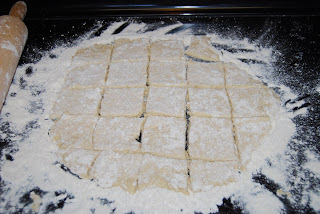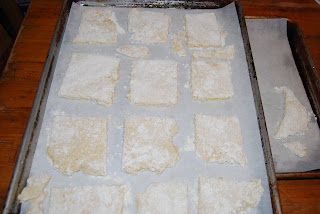I stumbled across this recipe on the Glutenfree.com
forum. I have tried for years to find a
descent yeast bread recipe that didn’t have wheat in it. I tried this recipe like I have tried others – with little
hope for a successful outcome. And since
I use my own wheat-free flour blend I never know if it will work in a
gluten-free recipe.
To my surprise, it worked! They rose a little and tasted amazing. I’ve made crescent rolls, pizza, and flat
bread with this recipe and I am very excited about it. The dough is very sticky – so you have to
have a lot of wheat-free flour in reserve to dust your surface with and the
dough so you can roll it out. My favorite
way to make it is to roll it in as best of a rectangle I can, and then cut it
into squares. After baking, they usually
are just thick enough to cut carefully cut down the center with a bread knife
and then they can fit in the toaster, or be filled with sandwich makings J You can find the original recipe for Mrs. P’s
Gluten Free Yeast/Crescent Rolls here: http://forums.glutenfree.com/topic4073.html
I adjusted a few things including my own flour
blend, but I also reduced the amount of xanthum gum because I have learned that
if I have too much of it – it upsets my stomach too (the whole purpose of eliminating
wheat!). Here it is…
(Note that it is Wheat-Free NOT
Gluten-Free)
Wheat-Free
Yeast Bread (doubled)
4 ½ teaspoons yeast
Almost 2 cups milk (I heat in the microwave for a minute and a half and then cool slightly)
½ cup sugar
1 ½ teaspoon salt
2 eggs
8 Tablespoons margarine (plus some additional melted to brush on top of baked bread if desired)
3 cups Wheat-Free Flour mix (below) with additional to roll out dough
1 ½ teaspoons xanthum gum
4 ½ teaspoons yeast
Almost 2 cups milk (I heat in the microwave for a minute and a half and then cool slightly)
½ cup sugar
1 ½ teaspoon salt
2 eggs
8 Tablespoons margarine (plus some additional melted to brush on top of baked bread if desired)
3 cups Wheat-Free Flour mix (below) with additional to roll out dough
1 ½ teaspoons xanthum gum
Wheat-Free Flour Mix
4 cups oat
flour
2 ½ cups brown rice flour
1 cup potato starch
1 cup corn flour
1 cup tapioca flour or starch
2 ½ cups brown rice flour
1 cup potato starch
1 cup corn flour
1 cup tapioca flour or starch
Directions:
Mix the dry ingredients in a medium size bowl
(yeast, sugar, salt, Wheat-Free Flour Mix and xanthum gum. Then cut up margarine and add it to the bowl.
Blend the margarine into the dry ingredients with an
electric mixer.
Generously dust your surface with the Wheat-Free
Flour Mix.
Drop some of the dough into the center of your
dusted surface with a spoon and
generously dust the top of the dough.
generously dust the top of the dough.
Roll dough gently, adding more Wheat-Free Flour Mix
as necessary to prevent sticking.
Gently cut dough into squares with a knife.
Transfer the squares (and excess if desired) to a
parchment paper lined cookie sheet with a Wheat-Free Flour Mix dusted spatula. Let the dough rise until double (30-60 minutes). Bake in a pre-heated 450 degree Fahrenheit
oven for about 10-12 minutes.
Remove from the oven and gently brush the tops with
melted margarine (if desired).
Cool on the cookie sheet and then store in a large plastic
re-sealable bag. I’ve been able to keep
the bag on my counter for a few days and then I transfer it to the refrigerator
to preserve it for a slightly longer time than it lasts on the counter.
Once it has been refrigerated it will crumble easier – but still tastes great.
Once it has been refrigerated it will crumble easier – but still tastes great.
Enjoy!














